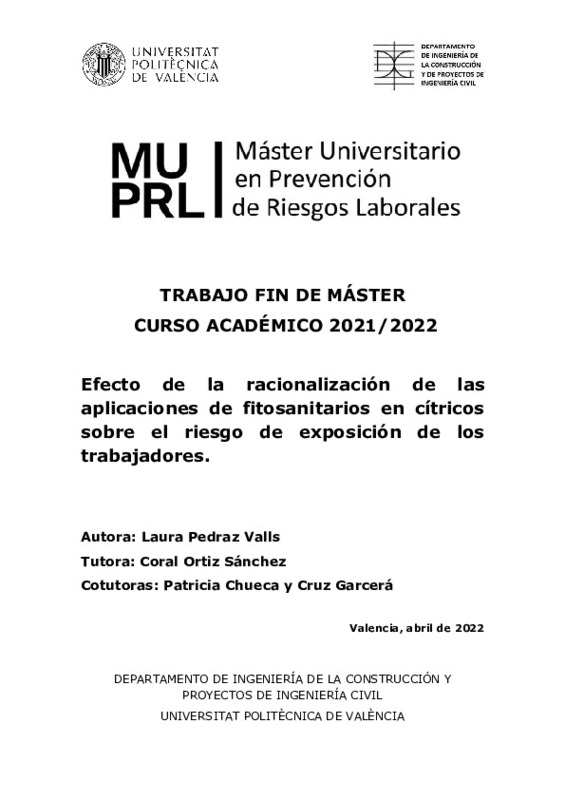|
Resumen:
|
[ES] La aplicación de productos fitosanitarios para la mejora de la producción y control de plagas en los cultivos es necesaria para mantener un nivel productivo adecuado para alimentar a la población, ya que esto todavía ...[+]
[ES] La aplicación de productos fitosanitarios para la mejora de la producción y control de plagas en los cultivos es necesaria para mantener un nivel productivo adecuado para alimentar a la población, ya que esto todavía no es posible empleando únicamente las técnicas de control no químico actualmente disponibles. Aunque un uso inadecuado de los productos fitosanitarios puede tener efectos adversos tanto para las personas como para el medio ambiente.
Con el presente trabajo se pretende determinar la reducción de la exposición a producto fitosanitario de un trabajador durante una aplicación optimizada en plantaciones de cítricos, donde los parámetros del equipo se han modificado para evitar un exceso de producto que puede llegar tanto al medio ambiente como al ser humano, frente a una aplicación convencional, donde los parámetros del equipo se establecen en base a tradiciones y creencias empíricas.
Estos estudios se enmarcan dentro del proyecto europeo PERFECT LIFE (PEsticide Reduction using Friendly and Environmentally Controlled Technologies (ref. LIFE17/ENV/ES/000205)) financiado por el programa Life de la Comisión Europea (2018-2022), llevado a cabo por el IVIA (Instituto Valenciano de Investigaciones Agrarias) entre otros. A través de este proyecto se busca la reducción de la contaminación ambiental por pesticidas y sus metabolitos asociados en el aire teniendo en cuenta las condiciones agrícolas reales, disminuyendo de esta forma el riesgo para el aplicador y las personas circundantes.
Se realizaron mediciones indirectas de la exposición dérmica analizando el pesticida depositado sobre el mono de protección de los diferentes grupos de población considerados. También se estimó la deriva que alcanza la zona de evaluación mediante colectores artificiales, analizando la deriva depositada en el suelo mediante colectores horizontales de papel secante y la deriva atmosférica empleando colectores verticales de hilos de nylon.
Se analizaron los resultados para cada trabajador mediante análisis de varianza múltiple y se determinó la parte del cuerpo que mayor exposición sufre.
[-]
[EN] The application of phytosanitary products to improve production and pest control in crops is necessary to maintain an adequate production level to feed the population, since this is still not possible using only ...[+]
[EN] The application of phytosanitary products to improve production and pest control in crops is necessary to maintain an adequate production level to feed the population, since this is still not possible using only non-chemical control techniques currently available. Although an inappropriate use of phytosanitary products could produce adverse effects both for people and the environment.
This thesis aims to determine the reduction of the exposure to a phytosanitary product of a worker during an optimized application in citrus plantations, where the parameters of the equipment have been modified to avoid an excess of product that can reach both the environment and the humans, as opposed to a conventional application, where the parameters of the equipment are established based on traditions and empirical beliefs.
These studies are part of the European project PERFECT LIFE (PEsticide Reduction using Friendly and Environmentally Controlled Technologies (ref. LIFE17/ENV/ES/000205)) financed by the Life program of the European Commission (2018-2022), carried out by the IVIA (Valencian Institute of Agricultural Research) among others. Through this project, the reduction of environmental contamination by pesticides and their associated metabolites in the air is sought, taking into account the real agricultural conditions, thus reducing the risk for the applicator and the surrounding people.
Indirect measurements of dermal exposure were made by analyzing the pesticide deposited on the protective overalls of the different population groups considered. The drift that reaches the evaluation zone was also estimated by means of artificial collectors, analyzing the drift deposited on the ground by means of horizontal collectors of blotting paper and the atmospheric drift using vertical collectors of nylon threads.
The results for each worker were analyzed by multiple variance analysis and the part of the body that suffers the greatest exposure was determined.
[-]
|







